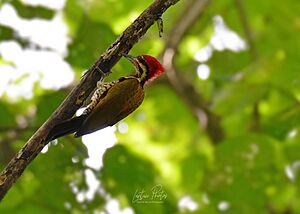Spot-throated flameback facts for kids
Quick facts for kids Spot-throated flameback |
|
|---|---|
 |
|
| Conservation status | |
| Scientific classification | |
| Genus: |
Dinopium
|
| Species: |
everetti
|
The spot-throated flameback (Dinopium everetti) is a type of bird that belongs to the Picidae family, which includes woodpeckers. This special bird lives only in the Philippines. You can find it on the island of Palawan and nearby islands like Balabac, Busuanga, and Calamian.
Sometimes, people think this bird is a type of common flameback. The spot-throated flameback likes to live in wet lowland forests. This includes old forests, newer forests, and even places like farms with trees. However, its home is in danger because of habitat loss.
Contents
What Does the Spot-throated Flameback Look Like?
The spot-throated flameback is a large woodpecker. It has a whitish belly with dark, scale-like patterns. Its back is golden-olive with a reddish mark that isn't very clear. Its throat is pale cream and has fine spots.
How to Tell Males and Females Apart
- Female birds have a black crest (the feathers on top of their head) with a red tip.
- Male birds have an all-red crest.
- Males also have a small red patch that looks like a moustache.
Spot-throated Flameback vs. Red-headed Flameback
This bird looks a bit like the Red-headed Flameback. But the Spot-throated Flameback has black and white stripes on its head. It also has a dark beak, not a pale yellow one.
What Does It Sound Like?
The Spot-throated Flameback makes a loud, fast sound. It sounds like a "ki-ki-ki-ki-ki-ki-ki-ki!" that gets quieter at the end.
Where Does the Spot-throated Flameback Live?
This flameback lives in forests and open woodlands. It can even be found in coconut farms. This shows it can live in places changed by humans. However, it is still not a common bird to see. It usually lives in lowland areas. They are known to lay eggs and raise their young in March and April.
Protecting the Spot-throated Flameback
The IUCN has listed this bird as "near-threatened." This means it could become endangered if we don't protect it. Scientists believe there are about 2,500 to 9,999 adult birds left.
Why Is This Bird in Danger?
The biggest danger to the spot-throated flameback is habitat loss. This means their forest homes are disappearing.
- Many lowland forests on Palawan have been cut down or damaged.
- This problem is still happening.
- Companies have been allowed to cut down trees and dig for minerals in most of the remaining forests.
- People are also cutting down trees illegally in the southern parts of the island.
How Can We Help?
Experts suggest we need to learn more about what this bird needs to survive. We also need to know if it can live in forests that are damaged or broken into smaller pieces. It's also very important to protect the areas where these birds already live.



